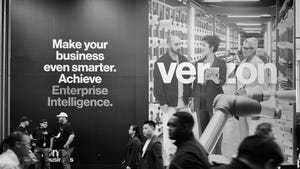Company says the 8M homes it will pass in '07 with U-verse is included in the 19M it will pass by the end of '08

Has AT&T Inc. (NYSE: T) cut the number of homes it expects to pass this year with the network powering its U-verse service?
Nope. But media reports this morning mistook a breakout of the carrier's 2007 buildout plans as a huge disruption in the U-verse space/time continuum.
Ma Bell CFO Rick Linder, during the company's conference call Jan. 25, gave a breakdown of where the company is in its U-verse goal. "We will expand our build to pass 8 million living units by the end of this year," he said. He also noted: "We're working now on a few final adjustments to the software and video infrastructure, and then we will begin ramping the product launch." (See AT&T Reports Healthy Q4.)
Several articles and blog posts this morning described the 8 million figure as a "new goal" for a new year. AT&T spokeswoman Destiny Belknap says that's not accurate. "Our goal of passing 19 million living units by 2008 hasn't changed," she says.
What Linder revealed, though, is that in 2007 AT&T is aiming to pass 8 million homes, apartments, etc., so it will tackle about 42 percent of its goal in the next several months.
Of course, Linder's comments have attracted attention because AT&T's U-verse rollout is under constant scrutiny and because the carrier has moved the goalposts in the past.
Table 1: Project Lightspeed/U-verse Projection Tracker
Date | Homes Passed Goal | Time Projected |
Nov-04 | 18 million | By 2007 |
Feb-05 | 19 million | By 2007 |
Mar-05 | 18 million | By 2007 |
Dec-05 | 18 million | First half of 2008 |
Feb-06 | 18 million | End of 2008 |
May-06 | 19 million | End of 2008 |
Mar-07 | 19 million | End of 2008, with 8 million passed in 2007 alone |
Source: Light Reading reports and SBC/AT&T public statements |
In 2004, back when the new AT&T was still the old SBC, the company's initial talk about its Project Lightspeed network, the network U-verse runs on, had the carrier hitting 18 million households by 2007.
In early 2005, the company upped the ante to say it would reach 19 million homes by the end of 2007. By the end of March 2005, it quickly ratcheted that figure back down to 18 million homes passed by 2007. (See Give or Take a Million.)
In December 2005, public statements show the company's goal began to tiptoe out a few months. At that time, the company said it would reach "approximately 18 million households by the first half of 2008 as part of initial deployment."
In February 2006, the first half of 2008 suddenly seemed a bit brash. "AT&T is deploying a two-way, interactive, switched IP video network and extending approximately 40,000 miles of new fiber optics to initially reach 18 million households by the end of 2008," the company said in a press release.
By May 2006, the carrier was standing by its end-of-2008 timeline, but this time it added another million homes to the goal. "AT&T plans to spend approximately $4.6 billion on its Project Lightspeed initiative to reach nearly 19 million homes by year-end 2008 as part of its initial deployment," the company said in a press release.
For the record, it appears the carrier has been singing the same hymn since early 2006: 19 million homes (well, "living units") passed by the end of 2008. And that goal still hasn't changed.
What did change, toward the end of 2006, was the carrier's stance on how many markets it would occupy with Project Lightspeed and its associated U-verse services. In December, AT&T moved back -- and hit -- its goal regarding the number of markets its U-verse service would appear in. (See AT&T Hits Lowered U-verse Goal).
Table 2: Project Lightspeed/U-verse Market Watcher
Date | Project Lightspeed/U-verse Event |
25-Jul-06 | AT&T says it will offer U-verse services in 15 to 20 markets by the end of 2006. |
23-Oct-06 | AT&T backs off on its U-verse goal slightly, saying now it expects to launch services in "approximately 15 markets" by the end of 2006. |
21-Dec-06 | In its announcement regarding the launch of U-verse services in the Bay Area, AT&T again lowers its goal. The release states: "AT&T now expects to launch AT&T U-verse in eleven markets by the end of the year, with plans to launch in additional markets in early 2007." |
28-Dec-06 | AT&T clears its lowered hurdle with the launch of U-verse services in four Indiana cities: Indianapolis, Anderson, Muncie, and Bloomington. |
Source: AT&T press releases and Light Reading reports |
CFO Linder's other notes about U-verse from the company's conference call included more praise for the often derided fiber-to-the-node architecture. "We've now launched U-verse service in 11 markets; all of these markets have HDTV. Our fiber-to-the-node architecture is performing well," he said. "Bandwidth delivered to homes is as good as, or better than, originally forecast."
He also noted that 70 percent of the customers who sign up take high-end video packages, and 70 percent of the customers are taking AT&T's highest offered broadband speed, which is only 6 Mbit/s.
— Phil Harvey, Managing Editor, Light Reading
About the Author(s)
You May Also Like











